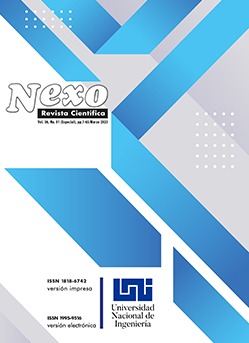Kinetics of the reaction between Moringa oleifera leaf extracts and 2,2-diphenyl-1-picrylhydrazyl (DPPH) free radical
DOI:
https://doi.org/10.5377/nexo.v36i01.15792Keywords:
Moringa oleifera, Leaching, Bi-exponential model, Rate constantAbstract
In this study, an antioxidant-rich extract was obtained by leaching Moringa oleifera leaves. The activity of the extract against the 2,2-diphenyl-1-picrylhydrazyl (DPPH) free radical was measured by determining a second-order rate constant (k2). The reaction between the mixture of antioxidants in the extract and the DPPH was monitored by measuring the absorbance at 517 nm in 30-second intervals for a period of 600 s. The absorbance exhibited a rapid decay within the first 100 s, followed by a slower decay. The absorbance data were fitted to a bi-exponential model. The curve fitting showed a linear relationship between the initial concentration of antioxidants and the reaction rate with the coefficient of determination values greater than 0.9979. The k2 value was 0.0870 ± 0.0007 mg/mL.
Downloads
1319
Downloads
Published
How to Cite
Issue
Section
License
Copyright (c) 2023 Universidad Nacional de Ingeniería

This work is licensed under a Creative Commons Attribution 4.0 International License.
The authors who publish in Nexo Scientific Journal agree to the following terms:
- Authors retain the copyright and grant the journal the right of the first publication under the license Creative Commons Attribution License, which allows others to share the work with a recognition of the authorship of the work and the initial publication in Nexo Scientific Journal.
- Authors may separately establish additional agreements for the non-exclusive distribution of the version of the work published in the journal (for example, in an institutional repository or a book), with the recognition of the initial publication in Nexo Scientific Journal.
- Authors are allowed and encouraged to disseminate their works electronically (for example, in institutional repositories or in their own website) before and during the submission process, as it can lead to productive exchanges, as well as earlier and greater citation of published works.










